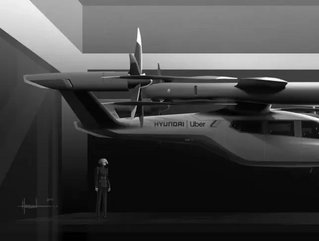Uber and Hyundai: the future of air taxis

With 2020 fully underway, the new decade is proving to continue 2019’s roaring innovation. The latest concept Uber Air Taxis!
This week, Hyundai became the first automotive company to join the Uber Elevate Initiative. Via Uber’s open design process, Hyundai has released its air vehicle concept. Inspired by NASA’s approach the recently released design concept is accessible to any company in order to jump-start innovation within the industry.
“Hyundai is our first vehicle partner with experience of manufacturing passenger cars on a global scale. We believe Hyundai has the potential to build Uber Air vehicles at rates unseen in the current aerospace industry, producing high quality, reliable aircraft at high volumes to drive down passenger costs per trip. Combining Hyundai’s manufacturing muscle with Uber’s technology platform represents a giant leap forward for launching a vibrant air taxi network in the coming years,” says Eric Allison, Head of Uber Elevate.
What is included within the partnership?
As part of the partnership, Hyundai will produce and deploy air vehicles, while Uber will provide airspace support services, ground transportation connections and a customer interface. In addition to these separate roles, Hyundai and Uber will jointly work on infrastructure concepts to support take-off and landing for the new style of vehicles.
SEE ALSO:
“Our vision of Urban Air Mobility will transform the concept of urban transportation. We expect UAM to vitalize urban communities and provide more quality time to people. We are confident that Uber Elevate is the right partner to make this innovative product readily available to as many customers as possible,” says Jaiwon Shin, Executive Vice President and Head of Hyundai’s Urban Air Mobility (UAM) Division.
Currently, Uber and Hyundai have developed a Personal Air Vehicle (PAV) model, S-A1. The model utilises innovative design processes to optimise electrical vertical take-off and landing (eVTOL).
Its main features include:
-
A cruising speed of up to 180 miles/hr (290 km/hr)
-
A cruising altitude of roughly 1,000-2,000 feet (300 - 600 mt) above ground
-
Fly trips up to 60 mile (100 km)
-
100% electric, utilising distributed electric propulsion
-
Designed for four passengers
(Image: Hyundai)
- Tesla reveals new battery tech but falls short of hypeDigital Transformation
- Waymo raises $3bn for vision of autonomous vehicle futureAI & Machine Learning
- Tech profile: Aurora - the self-drive startupAI & Machine Learning
- Autonomous robotaxis on horizon as Waymo raises $2.25bnDigital Transformation






